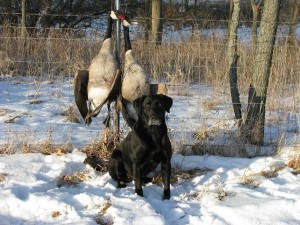Another weekend approaches and “Opening Day” slides further south along with the migration. Canada goose numbers continue to build in the upper Mississippi Flyway and Pintail numbers are building from the Klamath Basin to the Sacramento Valley. Increased rainfall has supplied much needed moisture to areas to parts of the eastern Central Flyway and The Great Lakes, though much more is needed to recharge the bulk of shallow wetlands.
Hello folks, and, as always, welcome to Waterfowler.com.
It’s mid-October and folks around the office are still wearing shorts here in northern Illinois. Opening Day is less than seventy-two hours away and the marsh where we normally hold the annual WFC Opening Day hunt is a choked with dried canary grass on bed of cracked, dry soil.
Despite the grim conditions we face at the marsh, geese are thick. Thicker than thieves and during our scouting trips we have noticed changes in habits that are worth mentioning here, as many of you hunting in drought stricken areas are likely to notice the same behavior.
Geese, being creatures of habit often return to the same fields to feed, over and over, until the waste grain disappears. The impact of the drought on the corn crop not only reduced the harvest rate but also impacted the amount of waste grain left in fields and competition for that little grain that remains is high. As a result, geese are changing fields often. Late flying flocks seem to be avoiding the crowds, traveling further and using more fields. In addition, the number of ducks using those fields appears to be above average as well.
That said, opportunity is abound if you are willing to step out of your waders and the safety zone of tradition methods and hunt were the birds are. As you are scouting and seeking land access, be aware that many states require you to carry a signed permission slip from the landowner to hunt. Even in states that do not require a consent form, it is a good idea to have one with you. Use the link below to access a standard form from the Ohio DNR or visit your state’s wildlife management website to download, print and store blank copies for your travels.
PACIFIC FLYWAY:
Hunting in the Pacific Northwest is fair to good in Washington, Oregon and Idaho, with duck numbers rising and goose numbers normal for this time of year. Pintail numbers are above average for this time of year in northern California with Gadwall numbers increasing from western Montana to the Great Salt Lake. Teal numbers are steady in the southern portion of the flyway but below average for this time of year.
CENTRAL FLYWAY:
Excellent hunting continues in Saskatchewan and Manitoba with duck numbers slightly below average for this time of year in Dakotas. Low water and dry conditions continue to impact hunter success across the U.S. Prairie Pothole region as ducks continue to migrate south and few birds trickle down from Canada. Duck numbers from Colorado to Nebraska are fair with goose numbers good. Teal and other early migrating birds continue to drift south past dry areas as numbers slowly build in the southern most wintering grounds.
MISSISSIPPI FLYWAY:
Above average temperatures and drought conditions continue to fuel early season lull for hunting in the northern most portion of the flyway. Hunting pressure has dropped slightly since opening day in far northern states and the relief is good for those trying who are happy to scratch out a few birds during the lull. Goose numbers continue to increase from Minnesota to Northern Illinois in preparation for the next round of season openers. With more rain on the horizon, hunters are hoping for any relief they can get from the coming precipitation.
ATLANTIC FLYWAY:
Sea duck numbers continue to rise along the coast of Maine and Massachusetts. Goose numbers are increasing from Southern Ontario to southeastern Pennsylvania and above average for this time of year. Duck numbers are slightly above average for this time of year throughout the New England states with teal good and wood ducks excellent. With habitat conditions good to excellent compared to the central United States, a better than average season is expected throughout the Atlantic Flyway.






